
by best-mag | Cryptocurrency
A currency in the most specific sense is money in any form when in use or circulation as a medium of exchange, especially circulating banknotes and coins. A more general definition is that a currency is a system of money in common use, especially for people in a nation.
Digital currency is any currency, money, or money-like asset that is primarily managed, stored or exchanged on digital computer systems, especially over the internet. Types of digital currencies include cryptocurrency, virtual currency and central bank digital currency.
Cryptocurrency, sometimes called crypto-currency or crypto, is any form of currency that exists digitally or virtually and uses cryptography to secure transactions. Cryptocurrencies don’t have a central issuing or regulating authority, instead using a decentralized system to record transactions and issue new units.
1.Bitcoin (BTC)
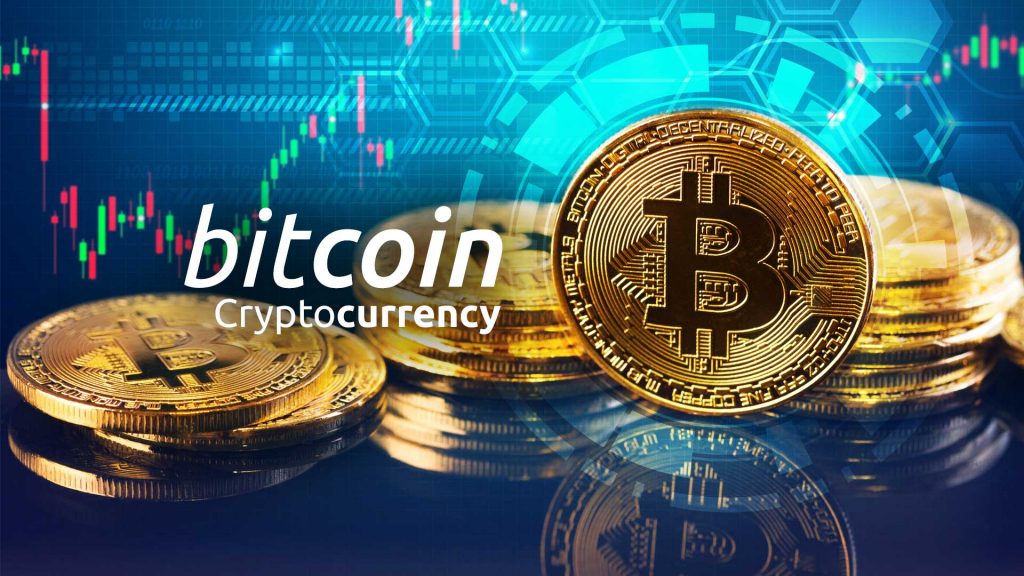
Rank #1
site: bitcoin.org , btc.com , bitcointalk.org
Explorers:blockchair.com/bitcoin
https://github.com/bitcoin/bitcoin
https://www.reddit.com/r/Bitcoin/
https://facebook.com/bitcoins
https://twitter.com/bitcoin
Bitcoin is an innovative payment network and a new kind of money.
Bitcoin uses peer-to-peer technology to operate with no central authority or banks; managing transactions and the issuing of bitcoins is carried out collectively by the network. Bitcoin is open-source; its design is public, nobody owns or controls Bitcoin and everyone can take part. Through many of its unique properties, Bitcoin allows exciting uses that could not be covered by any previous payment system.
Fast peer-to-peer transactions
Worldwide payments
Low processing fees
The concept of Bitcoin (BTC) was originally proposed by Nakamoto in 2009. Its open source software, designed according to Nakamoto’s ideas, is also a P2P network. Bitcoin is a digital currency in the form of P2P. Peer-to-peer transmission means a decentralized payment system.
Bitcoin is a decentralized digital currency, without a central bank or single administrator, that can be sent from user to user on the peer-to-peer bitcoin network without the need for intermediaries.
Is BTC a safe investment?
First things first: The money you put into Bitcoin is not safe from value fluctuations. Bitcoin is a volatile investment. If you’re looking for a “safe” investment with guaranteed returns, then don’t invest in Bitcoin — or any cryptocurrencies for that matter.
Satoshi Nakamoto is the name used by the presumed pseudonymous person or persons who developed bitcoin, authored the bitcoin white paper, and created and deployed bitcoin’s original reference implementation. As part of the implementation, Nakamoto also devised the first blockchain database.
Bitcoin’s source code repository on GitHub lists more than 750 contributors, with some of the key ones being Wladimir J. van der Laan, Marco Falke, Pieter Wuille, Gavin Andresen, Jonas Schnelli and others.
How many Satoshi Makes 1 BTC? 100 million satoshis
The satoshi to bitcoin ratio is 100 million satoshis to one bitcoin.
Crypto Wallets
The most popular wallets for cryptocurrency include both hot and cold wallets. Cryptocurrency wallets vary from hot wallets and cold wallets. Hot wallets are able to be connected to the web, while cold wallets are used for keeping large amounts of coins outside of the internet. Some of the top crypto cold wallets are Trezor, Ledger and CoolBitX. Some of the top crypto hot wallets include Exodus, Electrum and Mycelium.
Where Can You Buy Bitcoin (BTC)?
Bitcoin is, in many regards, almost synonymous with cryptocurrency, which means that you can buy Bitcoin on virtually every crypto exchange — both for fiat money and other cryptocurrencies. Some of the main markets where BTC trading is available are:
Binance
Coinbase Pro
OKEx
Kraken
Huobi Global
Bitfinex
2.Ethereum (ETH)
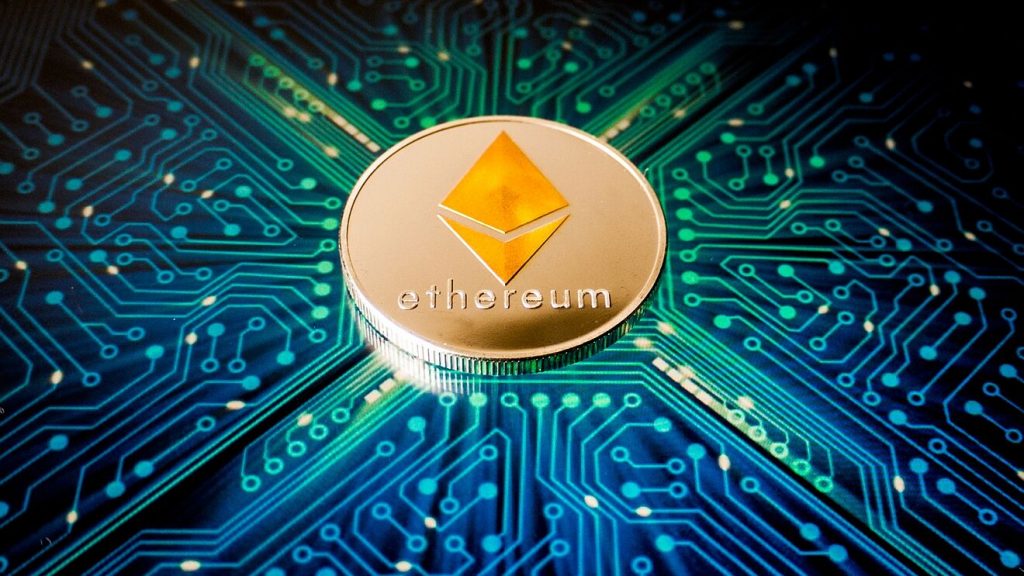
Rank #2
site:www.ethereum.org
Explorers :https://etherscan.io
Community :
https://forum.ethereum.org
https://github.com/ethereum/go-ethereum
https://twitter.com/ethereum
https://reddit.com/r/ethereum
Ethereum is the community-run technology powering the cryptocurrency ether (ETH) and thousands of decentralized applications.
Ethereum is a decentralized, open-source blockchain with smart contract functionality. Ether is the native cryptocurrency of the platform. Among cryptocurrencies, Ether is second only to Bitcoin in market capitalization. Ethereum was conceived in 2013 by programmer Vitalik Buterin.
What is Ethereum?
Ethereum is a technology that’s home to digital money, global payments, and applications. The community has built a booming digital economy, bold new ways for creators to earn online, and so much more. It’s open to everyone, wherever you are in the world – all you need is the internet.
Ethereum is a decentralized open-source blockchain system that features its own cryptocurrency, Ether. ETH works as a platform for numerous other cryptocurrencies, as well as for the execution of decentralized smart contracts.
Ethereum was first described in a 2013 whitepaper by Vitalik Buterin. Buterin, along with other co-founders, secured funding for the project in an online public crowd sale in the summer of 2014. The project team managed to raise $18.3 million in Bitcoin, and Ethereum’s price in the Initial Coin Offering (ICO) was $0.311, with over 60 million Ether sold. Taking Ethereum’s price now, this puts the return on investment (ROI) at an annualized rate of over 270%, essentially almost quadrupling your investment every year since the summer of 2014.
The Ethereum Foundation officially launched the blockchain on July 30, 2015, under the prototype codenamed “Frontier.” Since then, there has been several network updates — “Constantinople” on Feb. 28, 2019, “Istanbul” on Dec. 8, 2019, “Muir Glacier” on Jan. 2, 2020, “Berlin” on April 14, 2021, and most recently on Aug. 5, 2021, the “London” hard fork.
Ethereum’s own purported goal is to become a global platform for decentralized applications, allowing users from all over the world to write and run software that is resistant to censorship, downtime and fraud.
Ethereum 2.0
In 2022, Ethereum plans to switch to proof-of-stake with its Ethereum 2.0 update. This switch has been in the Ethereum roadmap since the network’s inception and would see a new consensus mechanism, as well as introduce sharding as a scaling solution. The current Ethereum chain will become the Beacon Chain and serve as a settlement layer for smart contract interactions on other chains.
In late 2021, Ethereum’s Arrow Glacier update was delayed to June 2022. Until then, Vitalik Buterin expects the road to the network’s endgame to be shaped by optimistic rollups and Zk-rollups.
3.BNB(BNB)
site:https://www.binance.com
Explorers : https://explorer.binance.org
https://github.com/binance-exchange/binance-official-api-docs
https://twitter.com/binance
https://reddit.com/r/binance
BNB is the cryptocurrency coin that powers the BNB Chain ecosystem. As one of the world’s most popular utility tokens, not only can you trade BNB like any other cryptocurrency, you can also use BNB in a wide range of applications and use cases.Use BNB to pay for goods and services, settle transaction fees on Binance Smart Chain, participate in exclusive token sales and more.
BNB uses an Auto-Burn system to reduce its total supply to 100,000,000 BNB. The BNB Auto-Burn mechanism adjusts the amount of BNB to be burned based on BNB’s price and the number of blocks generated on BNB Smart Chain (BSC) during the quarter. This offers greater transparency and predictability to the BNB community.
BNB lost in eligible cases can also be reimbursed through the BNB Pioneer Burn Program. This counts users’ lost coins towards the official burn count and reimburses them with BNB.
BNB additionally uses a real-time burning mechanism based on gas fees. A fixed ratio of the gas fee collected is burned in each block, with the ratio decided by BSC validators.
Launched in July 2017, Binance is the biggest cryptocurrency exchange globally based on daily trading volume. Binance aims to bring cryptocurrency exchanges to the forefront of financial activity globally. The idea behind Binance’s name is to show this new paradigm in global finance — Binary Finance, or Binance.
Aside from being the largest cryptocurrency exchange globally, Binance has launched a whole ecosystem of functionalities for its users. The Binance network includes the Binance Chain, Binance Smart Chain, Binance Academy, Trust Wallet and Research projects, which all employ the powers of blockchain technology to bring new-age finance to the world. BNB is an integral part of the successful functioning of many of the Binance sub-projects.
There is an initial maximum supply of 200,000,000 BNB coins, of which 168,137,036 are currently in circulation as of September 2021.
4.Cardano (ADA)
site:https://www.cardano.org
Explorers :https://explorer.cardano.org , https://cardanoscan.io
Source code :https://cardanoupdates.com
Community :
https://t.me/CardanoAnnouncements
https://twitter.com/cardano
https://reddit.com/r/cardano
https://forum.cardano.org/
Cardano is a blockchain platform for changemakers, innovators, and visionaries, with the tools and technologies required to create possibility for the many, as well as the few, and bring about positive global change.
Cardano is a proof-of-stake blockchain platform: the first to be founded on peer-reviewed research and developed through evidence-based methods. It combines pioneering technologies to provide unparalleled security and sustainability to decentralized applications, systems, and societies.
Cardano is a public blockchain platform. It is open-source and decentralized, with consensus achieved using proof of stake. It can facilitate peer-to-peer transactions with its internal cryptocurrency, ADA. Cardano was founded in 2015 by Ethereum co-founder Charles Hoskinson
Cardano brings a new standard in technology – open and inclusive – to challenge the old and activate a new age of sustainable, globally-distributed innovation.
Cardano was founded back in 2017, and named after the 16th century Italian polymath Gerolamo Cardano. The native ADA token takes its name from the 19th century mathematician Ada Lovelace, widely regarded as the world’s first computer programmer. The ADA token is designed to ensure that owners can participate in the operation of the network. Because of this, those who hold the cryptocurrency have the right to vote on any proposed changes to the software.
The team behind the layered blockchain say that there have already been some compelling use cases for its technology, which aims to allow decentralized apps and smart contracts to be developed with modularity.
In August 2021, Charles Hoskinson announced the launch of the Alonzo hard fork, causing Cardano price to surge, gaining 116% in the following month. On Sept. 12, 2021, the Cardano ‘Alonzo’ hard fork officially launched, bringing smart contract functionality to the blockchain. Over 100 smart contracts were deployed in the following 24 hours after the launch.
5.Solana (SOL)
site: https://solana.com
Explorers : https://explorer.solana.com , https://solanabeach.io
Source code :https://github.com/solana-labs
Community :
https://forums.solana.com
https://twitter.com/solana
https://reddit.com/r/solana
Solana is a decentralized blockchain built to enable scalable, user-friendly apps for the world.Solana is the fastest blockchain in the world and the fastest growing ecosystem in crypto, with thousands of projects spanning DeFi, NFTs, Web3 and more.Solana ensures composability between ecosystem projects by maintaining a single global state as the network scales. Never deal with fragmented Layer 2 systems or sharded chains.Not only is Solana ultra-fast and low cost, it is censorship resistant. Meaning, the network will remain open for applications to run freely and transactions will never be stopped.
Solana is a public blockchain platform with smart contract functionality. Its native cryptocurrency is SOL. Solana claims to offer faster transaction times and lower costs than its main competitor, Ethereum.
Solana is a highly functional open source project that banks on blockchain technology’s permissionless nature to provide decentralized finance (DeFi) solutions. While the idea and initial work on the project began in 2017, Solana was officially launched in March 2020 by the Solana Foundation with headquarters in Geneva, Switzerland.
The Solana protocol is designed to facilitate decentralized app (DApp) creation. It aims to improve scalability by introducing a proof-of-history (PoH) consensus combined with the underlying proof-of-stake (PoS) consensus of the blockchain.
The Solana Foundation has announced that a total of 489 million SOL tokens will be released in circulation. At the moment, about 260 million of these have already entered the market.The SOL token distribution is as follows: 16.23% went towards an initial seed sale, 12.92% of tokens were dedicated to a founding sale, 12.79% of SOL coins were distributed among team members and 10.46% of tokens were given to the Solana Foundation. The remaining tokens were already released for public and private sales or are still to be released to the market.
6.Polkadot (DOT)
site: https://polkadot.network
Explorers : http://polkascan.io , https://polkastats.io
Source code :https://github.com/paritytech/polkadot
Community :
https://twitter.com/Polkadot
https://reddit.com/r/dot
Polkadot enables cross-blockchain transfers of any type of data or asset, not just tokens. Connecting to Polkadot gives you the ability to interoperate with a wide variety of blockchains in the Polkadot network.Polkadot provides unprecedented economic scalability by enabling a common set of validators to secure multiple blockchains. Polkadot provides transactional scalability by spreading transactions across multiple parallel blockchains.Create a custom blockchain in minutes using the Substrate framework. Connect your chain to Polkadot and get interoperability and security from day one. This ease of development helps Polkadot’s network grow.
The DOT token serves three distinct purposes: governance over the network, staking and bonding.
Polkadot is an open source, blockchain platform and cryptocurrency that allows for distributed computing. The network uses a proof of stake consensus algorithm. The protocol used, Blind Assignment for Blockchain Extension, is derived from Ouroboros.
Polkadot is an open-source project founded by the Web3 Foundation.Web3 Foundation has commissioned five teams and over 100 developers to build Polkadot.
Polkadot is an open-source sharded multichain protocol that connects and secures a network of specialized blockchains, facilitating cross-chain transfer of any data or asset types, not just tokens, thereby allowing blockchains to be interoperable with each other. Polkadot was designed to provide a foundation for a decentralized internet of blockchains, also known as Web3.
Polkadot is known as a layer-0 metaprotocol because it underlies and describes a format for a network of layer 1 blockchains known as parachains (parallel chains). As a metaprotocol, Polkadot is also capable of autonomously and forklessly updating its own codebase via on-chain governance according to the will of its token holder community.
Polkadot provides a foundation to support a decentralized web, controlled by its users, and to simplify the creation of new applications, institutions and services.
7.Dogecoin (DOGE)
site: http://dogecoin.com
Explorers : http://dogechain.info/chain/Dogecoin , https://doge.tokenview.com
Source code : https://github.com/dogecoin/dogecoin
Community :
https://twitter.com/dogecoin
https://reddit.com/r/dogecoin
Dogecoin is an open source peer-to-peer digital currency, favored by Shiba Inus worldwide.
THE FUN AND FRIENDLY INTERNET CURRENCY: Dogecoin sets itself apart from other digital currencies with an amazing, vibrant community made up of friendly folks just like you.
WHAT’S WITH DOGECOIN AND THE DOG? “Doge” is our fun, friendly mascot! The Shiba Inu is a Japanese breed of dog that was popularized as an online meme and represents Dogecoin.
Dogecoin is a cryptocurrency created by software engineers Billy Markus and Jackson Palmer, who decided to create a payment system as a “joke”, making fun of the wild speculation in cryptocurrencies at the time. It is considered both the first “meme coin”, and, more specifically, the first “dog coin”
Dogecoin (DOGE) is based on the popular “doge” Internet meme and features a Shiba Inu on its logo. The open-source digital currency was created by Billy Markus from Portland, Oregon and Jackson Palmer from Sydney, Australia, and was forked from Litecoin in December 2013. Dogecoin’s creators envisaged it as a fun, light-hearted cryptocurrency that would have greater appeal beyond the core Bitcoin audience, since it was based on a dog meme. Tesla CEO Elon Musk posted several tweets on social media that Dogecoin is his favorite coin.
Dogecoin differs from Bitcoin’s proof-of-work protocol in several ways, one of which is by using Scrypt technology. The altcoin has also a block time of 1 minute, and the total supply is uncapped, which means that there is no limit to the number of Dogecoin that can be mined. You can mine Dogecoin either solo, or by joining a mining pool. A Doge miner can mine the digital currency on Windows, Mac or Linux, and with a GPU.

Other Popular Cryptocurrency in 2021 and 2022 :
XRP (XRP ) :Ripple is a real-time gross settlement system, currency exchange and remittance network created by Ripple Labs Inc., a US-based technology company.
Terra (LUNA ) : Terra is a blockchain protocol that uses fiat-pegged stablecoins to power price-stable global payments systems. According to its white paper, Terra combines the price stability and wide adoption of fiat currencies with the censorship-resistance of Bitcoin (BTC) and offers fast and affordable settlements.
Avalanche (AVAX) : Avalanche is a decentralized, open-source proof of stake blockchain with smart contract functionality. AVAX is the native cryptocurrency of the platform.
Shiba Inu (SHIB) : According to the SHIBA INU website, SHIB is the “DOGECOIN KILLER” and is listed on their own ShibaSwap, a DEX. Shiba Inu coin was created anonymously in August 2020 under the pseudonym “Ryoshi.” Ryoshi says about himself that he is a nobody and not important and that the efforts to unmask his identity, even if successful, would be underwhelming.Shiba Inu token is a decentralized cryptocurrency created in August 2020 by an anonymous person or group known as “Ryoshi”
stablecoin ? stable-value cryptocurrency that mirrors the price of the U.S. dollar.
Popular stablecoin Cryptocurrency in 2021 and 2022 :
Tether (USDT)
USD Coin (USDC)
Binance USD (BUSD)
TerraUSD (UST)
Dai (DAI)

by best-mag | Cryptocurrency
Cryptographer David Chaum first proposed a blockchain-like protocol in his 1982 dissertation “Computer Systems Established, Maintained, and Trusted by Mutually Suspicious Groups.”Further work on a cryptographically secured chain of blocks was described in 1991 by Stuart Haber and W. Scott Stornetta. They wanted to implement a system wherein document timestamps could not be tampered with. In 1992, Haber, Stornetta, and Dave Bayer incorporated Merkle trees into the design, which improved its efficiency by allowing several document certificates to be collected into one block. Under their company Surety, their document certificate hashes have been published in The New York Times every week since 1995.
The first decentralized blockchain was conceptualized by a person (or group of people) known as Satoshi Nakamoto in 2008. Nakamoto improved the design in an important way using a Hashcash-like method to timestamp blocks without requiring them to be signed by a trusted party and introducing a difficulty parameter to stabilize the rate at which blocks are added to the chain. The design was implemented the following year by Nakamoto as a core component of the cryptocurrency bitcoin, where it serves as the public ledger for all transactions on the network.
In August 2014, the bitcoin blockchain file size, containing records of all transactions that have occurred on the network, reached 20 GB (gigabytes). In January 2015, the size had grown to almost 30 GB, and from January 2016 to January 2017, the bitcoin blockchain grew from 50 GB to 100 GB in size. The ledger size had exceeded 200 GB by early 2020.
The words block and chain were used separately in Satoshi Nakamoto’s original paper, but were eventually popularized as a single word, blockchain, by 2016.
According to Accenture, an application of the diffusion of innovations theory suggests that blockchains attained a 13.5% adoption rate within financial services in 2016, therefore reaching the early adopters’ phase.Industry trade groups joined to create the Global Blockchain Forum in 2016, an initiative of the Chamber of Digital Commerce.
In May 2018, Gartner found that only 1% of CIOs indicated any kind of blockchain adoption within their organisations, and only 8% of CIOs were in the short-term “planning or active experimentation with blockchain”.For the year 2019 Gartner reported 5% of CIOs believed blockchain technology was a ‘game-changer’ for their business

blockchain technology :
Blockchain technology is a structure that stores transactional records, also known as the block, of the public in several databases, known as the “chain,” in a network connected through peer-to-peer nodes. Typically, this storage is referred to as a ‘digital ledger.’
Every transaction in this ledger is authorized by the digital signature of the owner, which authenticates the transaction and safeguards it from tampering. Hence, the information the digital ledger contains is highly secure.
In simpler words, the digital ledger is like a Google spreadsheet shared among numerous computers in a network, in which, the transactional records are stored based on actual purchases. The fascinating angle is that anybody can see the data, but they can’t corrupt it.
How Does Blockchain Technology Work?
In recent years, you may have noticed many businesses around the world integrating Blockchain technology. But how exactly does Blockchain technology work? Is this a significant change or a simple addition? The advancements of Blockchain are still young and have the potential to be revolutionary in the future; so, let’s begin demystifying this technology.
Blockchain is a combination of three leading technologies:
- Cryptographic keys
- A peer-to-peer network containing a shared ledger
- A means of computing, to store the transactions and records of the network
Cryptography keys consist of two keys – Private key and Public key. These keys help in performing successful transactions between two parties. Each individual has these two keys, which they use to produce a secure digital identity reference. This secured identity is the most important aspect of Blockchain technology. In the world of cryptocurrency, this identity is referred to as ‘digital signature’ and is used for authorizing and controlling transactions.
The digital signature is merged with the peer-to-peer network; a large number of individuals who act as authorities use the digital signature in order to reach a consensus on transactions, among other issues. When they authorize a deal, it is certified by a mathematical verification, which results in a successful secured transaction between the two network-connected parties. So to sum it up, Blockchain users employ cryptography keys to perform different types of digital interactions over the peer-to-peer network.
Structure blockchain
Blockchain formation. The main chain (black) consists of the longest series of blocks from the genesis block (green) to the current block. Orphan blocks (purple) exist outside of the main chain.
A blockchain is a decentralized, distributed, and oftentimes public, digital ledger consisting of records called blocks that are used to record transactions across many computers so that any involved block cannot be altered retroactively, without the alteration of all subsequent blocks. This allows the participants to verify and audit transactions independently and relatively inexpensively.A blockchain database is managed autonomously using a peer-to-peer network and a distributed timestamping server. They are authenticated by mass collaboration powered by collective self-interests. Such a design facilitates robust workflow where participants’ uncertainty regarding data security is marginal. The use of a blockchain removes the characteristic of infinite reproducibility from a digital asset. It confirms that each unit of value was transferred only once, solving the long-standing problem of double-spending. A blockchain has been described as a value-exchange protocol. A blockchain can maintain title rights because, when properly set up to detail the exchange agreement, it provides a record that compels offer and acceptance.
Logically, a blockchain can be seen as consisting of several layers:
- infrastructure (hardware)
- networking (node discovery, information propagation and verification)
- consensus (proof of work, proof of stake)
- data (blocks, transactions)
- application (smart contracts/decentralized applications, if applicable)
The blockchain hardware accelerator uses a combination of a load dispatcher and a configurable number of instances of our Public Key Crypto Engine (BA414EP). This saves time and space as the transaction load is distributed among several components, thereby increasing the overall transaction speed and output.
Blockchain Block are data structures within the blockchain database, where transaction data in a cryptocurrency blockchain are permanently recorded. A block records some or all of the most recent transactions not yet validated by the network.
Most cryptocurrencies use blockchain technology to record transactions. For example, the bitcoin network and Ethereum network are both based on blockchain. On 8 May 2018 Facebook confirmed that it would open a new blockchain group which would be headed by David Marcus, who previously was in charge of Messenger. Facebook’s planned cryptocurrency platform, Libra (now known as Diem), was formally announced on June 18, 2019 .
A blockchain is a growing list of records, called blocks, that are linked together using cryptography. Each block contains a cryptographic hash of the previous block, a timestamp, and transaction data (generally represented as a Merkle tree). The timestamp proves that the transaction data existed when the block was published to get into its hash. As blocks each contain information about the block previous to it, they form a chain, with each additional block reinforcing the ones before it. Therefore, blockchains are resistant to modification of their data because once recorded, the data in any given block cannot be altered retroactively without altering all subsequent blocks.
Blockchain.com is a cryptocurrency financial services company. The company began as the first Bitcoin blockchain explorer in 2011 and later created a cryptocurrency wallet that accounted for 28% of bitcoin transactions between 2012 and 2020.
What is blockchain and how it works? Blockchain is a system of recording information in a way that makes it difficult or impossible to change, hack, or cheat the system. A blockchain is essentially a digital ledger of transactions that is duplicated and distributed across the entire network of computer systems on the blockchain.

What is Bitcoin’s blockchain?
Bitcoin’s blockchain is a distributed ledger, a series of linked blocks containing transaction records, that is undergirded by complex mining processes to ensure the integrity of transactions. The blockchain is public, meaning anyone can view transactions occurring on it.
What is blockchain Ethereum?
Ethereum is a decentralized blockchain platform that establishes a peer-to-peer network that securely executes and verifies application code, called smart contracts. Smart contracts allow participants to transact with each other without a trusted central authority.
Types of Blockchain:
Private Blockchain Networks
Public Blockchain Networks
Hash Encryptions
blockchain technology uses hashing and encryption to secure the data, relying mainly on the SHA256 algorithm to secure the information. The address of the sender (public key), the receiver’s address, the transaction, and his/her private key details are transmitted via the SHA256 algorithm. The encrypted information, called hash encryption, is transmitted across the world and added to the blockchain after verification. The SHA256 algorithm makes it almost impossible to hack the hash encryption, which in turn simplifies the sender and receiver’s authentication.

by best-mag | Travel
Italy is the fifth most visited country in international tourism, with a total of 52.3 million international arrivals in 2016. People mainly visit Italy for its rich culture, cuisine, history, fashion, architecture and art. Winter and summer tourism are present in many locations in the Alps and the Apennines, while seaside tourism is widespread in coastal locations on the Mediterranean Sea.
Italy is also the country with the highest number of UNESCO World Heritage Sites in the world .Rome is the 3rd most visited city in Europe and the 12th in the world, with 9.4 million arrivals in 2017 while Milan is the 27th worldwide with 6.8 million tourists.In addition, Venice and Florence are also among the world’s top 100 destinations.
1.Venice

Venice (/ˈvɛnɪs/ VEH-niss; Italian: Venezia ; Venetian: Venesia or Venexia is a city in northeastern Italy and the capital of the Veneto region. It is built on a group of 118 small islands that are separated by canals and linked by over 400 bridges.The islands are in the shallow Venetian Lagoon, an enclosed bay lying between the mouths of the Po and the Piave rivers (more exactly between the Brenta and the Sile). In 2020, 258,685 people resided in the Comune di Venezia, of whom around 55,000 live in the historical city of Venice (centro storico). Together with Padua and Treviso, the city is included in the Padua-Treviso-Venice Metropolitan Area (PATREVE), which is considered a statistical metropolitan area, with a total population of 2.6 million.
Venice is an important destination for tourists who want to see its celebrated art and architecture.The city hosts up to 60,000 tourists per day (2017 estimate). Estimates of the annual number of tourists vary from 22 million to 30 million. This “overtourism” creates overcrowding and environmental problems for Venice’s ecosystem. By 2017, UNESCO was considering the addition of Venice to its “In-Danger” list, which includes historical ruins in war-torn countries. To reduce the number of visitors, who are causing irreversible changes in Venice, the agency supports limiting the number of cruise ships as well as implementing a strategy for more sustainable tourism.
Tourism has been a major part of the Venetian economy since the 18th century, when Venice—with its beautiful cityscape, uniqueness, and rich musical and artistic cultural heritage—was a stop on the Grand Tour. In the 19th century, Venice became a fashionable centre for the “rich and famous”, who often stayed and dined at luxury establishments such as the Danieli Hotel and the Caffè Florian, and continued to be a fashionable city into the early 20th century.In the 1980s, the Carnival of Venice was revived; and the city has become a major centre of international conferences and festivals, such as the prestigious Venice Biennale and the Venice Film Festival, which attract visitors from all over the world for their theatrical, cultural, cinematic, artistic, and musical productions.
Today, there are numerous attractions in Venice, such as St Mark’s Basilica, the Doge’s Palace, the Grand Canal, and the Piazza San Marco. The Lido di Venezia is also a popular international luxury destination, attracting thousands of actors, critics, celebrities, and others in the cinematic industry. The city also relies heavily on the cruise business. The Cruise Venice Committee has estimated that cruise ship passengers spend more than 150 million euros (US$193 million) annually in the city, according to a 2015 report. Other reports, however, point out that such day-trippers spend relatively little in the few hours of their visits to the city.
Venice is regarded by some as a tourist trap, and by others as a “living museum”
2.Herculaneum
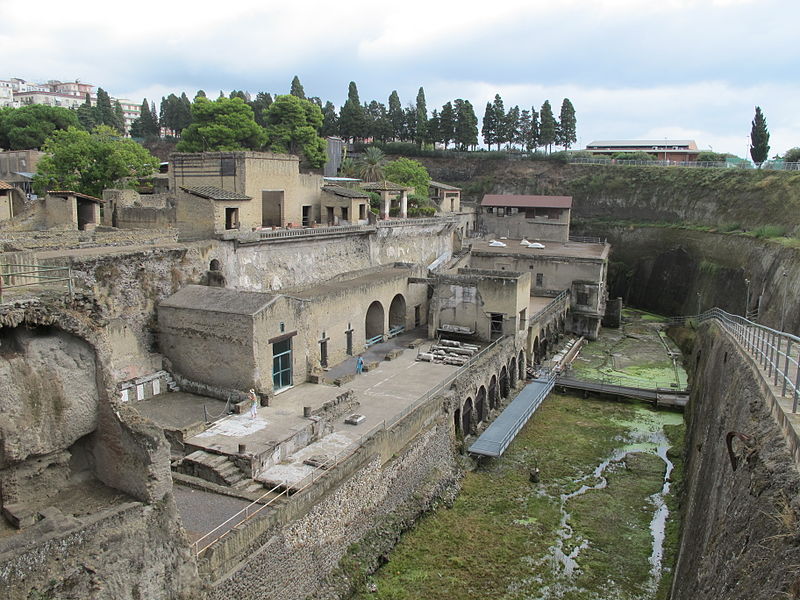
Herculaneum (/hɜːrkjʊˈleɪniəm/; Italian: Ercolano) was an ancient town, located in the modern-day comune of Ercolano, Campania, Italy. Herculaneum was buried under volcanic ash and pumice in the eruption of Mount Vesuvius in AD 79.
Like the nearby city of Pompeii, Herculaneum is famous as one of the few ancient cities to be preserved more or less intact as the ash that blanketed the town also protected it against looting and the elements. Although less well known today than Pompeii, it was the first, and for a long time the only, buried Vesuvian city to be found (in 1709), while Pompeii was only revealed from 1748 and identified in 1763.Unlike Pompeii, the mainly pyroclastic material that covered Herculaneum carbonized and preserved more wood in objects such as roofs, beds, and doors, as well as other organic-based materials such as food and papyrus.
Herculaneum is a city that there is now quite a bit of information on. However, for a while the city was eclipsed by the more well-known city of Pompeii. Although the cities are located a mere 13 km apart, Pompeii is often more popular in education systems than Herculaneum is. Herculaneum was discovered in 1709, whereas Pompeii wasn’t discovered until 39 years later in 1748. When Pompeii was discovered, a Russian named Karl Bryullov created an oil painting titled The Last Day of Pompeii which later inspired Edward Bulwer-Lytton to write his book The Last Days of Pompeii in 1834; both of which helped boost Pompeii’s popularity. Pompeii’s discovery caused excavations in Herculaneum to stop until the 1920s. This was due to the depth at which both cities were buried. While Herculaneum was buried underneath 20 meters of thick pyroclastic material, Pompeii was only covered with 4 meters of thinner ash, making it a significantly easier site to excavate.
3.Cinque Terre
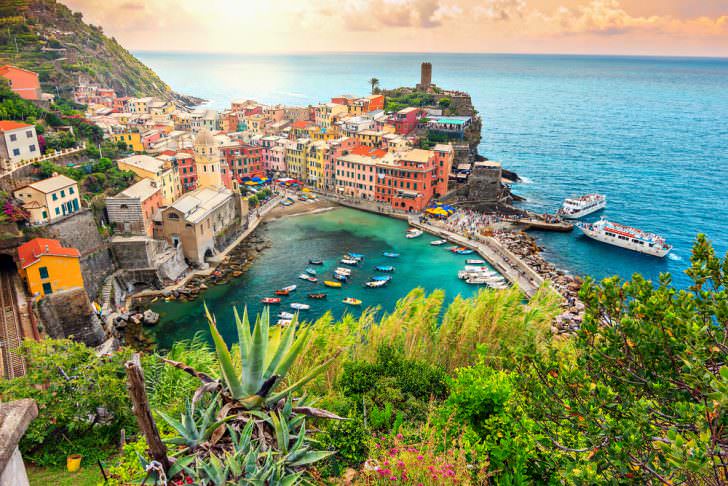
The Cinque Terre area is a popular tourist destination. Over the centuries, people have built terraces on the rugged, steep landscape right up to the cliffs that overlook the Ligurian Sea. Paths, trains, and boats connect the villages as cars can only reach them with great difficulty from the outside via narrow and precarious mountain roads.
Cinque Terre is mentioned in documents dating to the 11th century. Monterosso and Vernazza were settled first and the other villages grew later, whilst within the territory of the Republic of Genoa. In the 16th century, the inhabitants reinforced existing forts and built new defence towers to defend the area from attacks by the Turks
Access to Cinque Terre by car is limited. A road to Vernazza is very narrow and ends 1 kilometre (0.62 mi) before the town. Alternatively, drive to Bonassola, park your auto there, and take the local train two stops to Monterosso in the Cinque Terre. Trains run from La Spezia to all five towns within Cinque Terre, as well as to major regional and national destinations. The Cinque Terre railway stations are located on the Genoa-Pisa line. Most long-distance trains do not stop at all five Cinque Terre towns, making it necessary to transfer from La Spezia onto regional trains. Some intercity trains also stop at Monterosso Station.A scheduled passenger ferry runs between Levanto and La Spezia, stopping at all of the main villages except Corniglia, which does not have a landing point, as it is not located on the coast. Boats also connect to Genoa’s Old Harbour, Lerici, and Porto Venere.
Many walking trails run throughout the park and are named according to the SVA numbering system, however, it is common to hear trails referred to by their previous numbers, causing confusion to visitors.The most popular path is known as the Sentiero Azzurro (“Azure Trail”), used to connect the five villages.
Given its location on the Mediterranean, seafood is plentiful in the local cuisine. Anchovies of Monterosso are a local speciality designated with a Protected Designation of Origin status from the European Union.
4.Amalfi
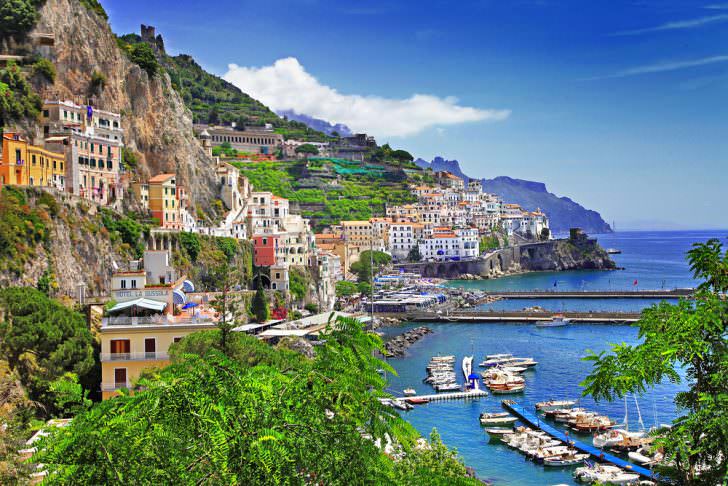
The town of Amalfi was the capital of the maritime republic known as the Duchy of Amalfi, an important trading power in the Mediterranean between 839 and around 1200.In the 1920s and 1930s, Amalfi was a popular holiday destination for the British upper class and aristocracy.
Amalfi is a town in a dramatic natural setting below steep cliffs on Italy’s southwest coast. Between the 9th and 11th centuries, it was the seat of a powerful maritime republic. The Arab-Norman Sant’Andrea cathedral at the heart of town, with its striped Byzantine facade, survives from this era. The Museo Arsenale Amalfi is a medieval shipyard-turned-exhibition space
Amalfi is the main town of the coast on which it is located, named Costiera Amalfitana (Amalfi Coast), and is today an important tourist destination together with other towns on the same coast, such as Positano, Ravello and others. Amalfi is included in the UNESCO World Heritage Sites.
5. Tower of Pisa
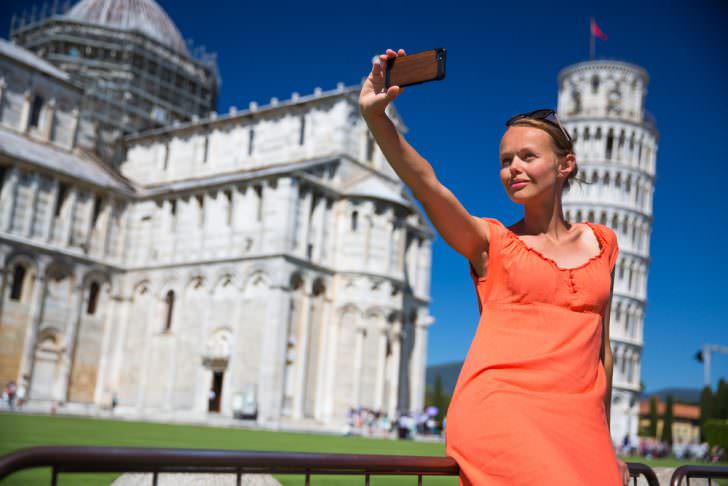
Construction of the tower occurred in three stages over 199 years. On 5 January 1172, Donna Berta di Bernardo, a widow and resident of the house of dell’Opera di Santa Maria, bequeathed sixty soldi to the Opera Campanilis petrarum Sancte Marie. The sum was then used toward the purchase of a few stones which still form the base of the bell tower. On 9 August 1173, the foundations of the tower were laid. Work on the ground floor of the white marble campanile began on 14 August of the same year during a period of military success and prosperity. This ground floor is a blind arcade articulated by engaged columns with classical Corinthian capitals. Nearly four centuries later Giorgio Vasari wrote: “Guglielmo, according to what is being said, in the year 1174, together with sculptor Bonanno, laid the foundations of the bell tower of the cathedral in Pisa”.
The Leaning Tower of Pisa (Italian: torre pendente di Pisa), or simply the Tower of Pisa , is the campanile, or freestanding bell tower, of the cathedral of the Italian city of Pisa, known worldwide for its nearly four-degree lean, the result of an unstable foundation.
6.Capri
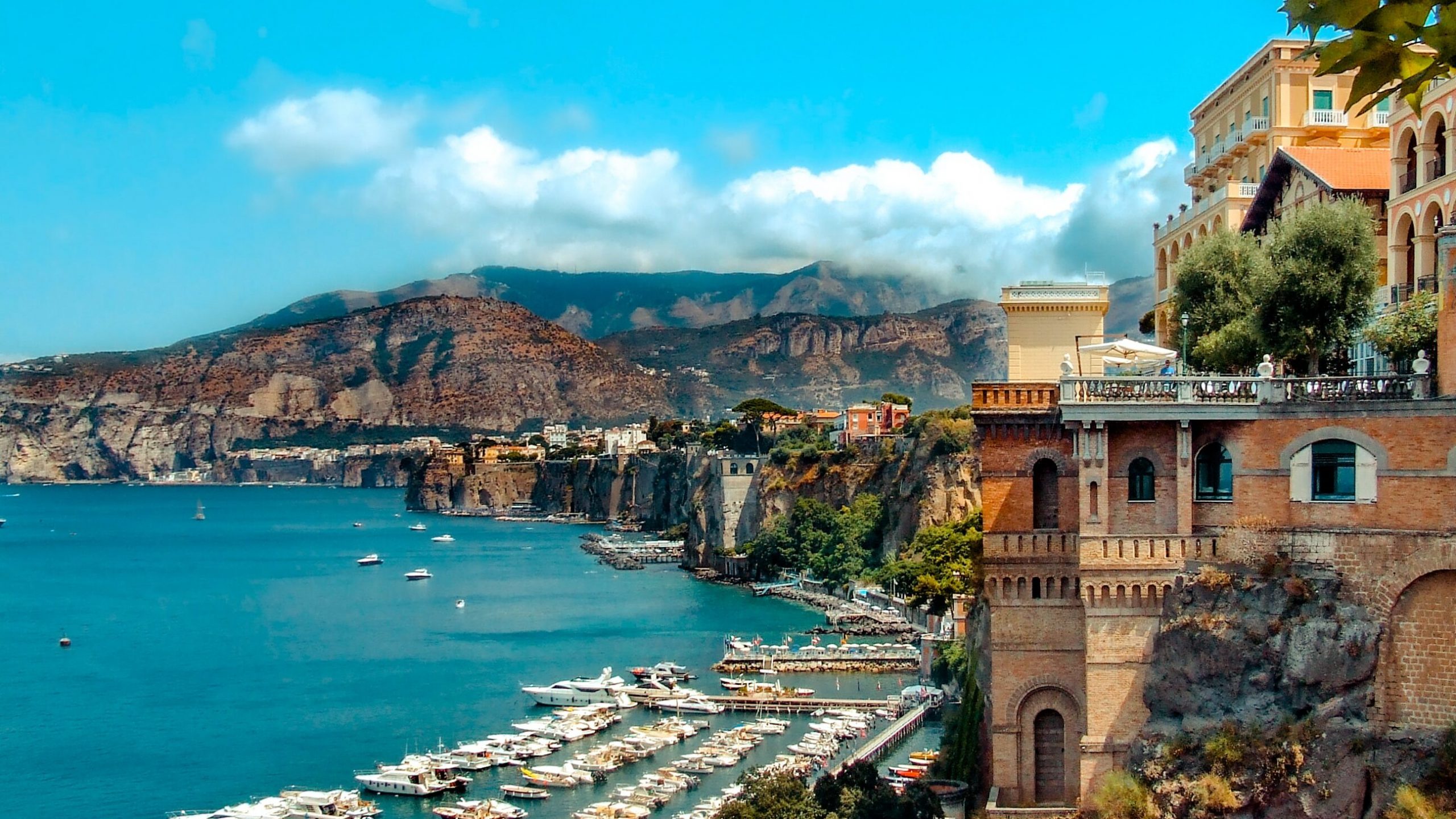
Island with resorts, shops & restaurants, offering mountaintop scenery & the famous Blue Grotto.
Capri, an island in Italy’s Bay of Naples, is famed for its rugged landscape, upscale hotels and shopping, from designer fashions to limoncello and handmade leather sandals. One of its best-known natural sites is the Blue Grotto, a dark cavern where the sea glows electric blue, the result of sunlight passing through an underwater cave. In summer, Capri’s dramatic, cove-studded coastline draws many yachts.
The most famous dish on Capri is ravioli capresi, made with a simple pasta dough using equal parts flour and water, resulting in a particularly light pasta. The filling is made with parmigiano and aged caciotta cheese, and marjoram, and the cooked ravioli are tossed with a fresh tomato and basil sauce.
7.Lake Garda
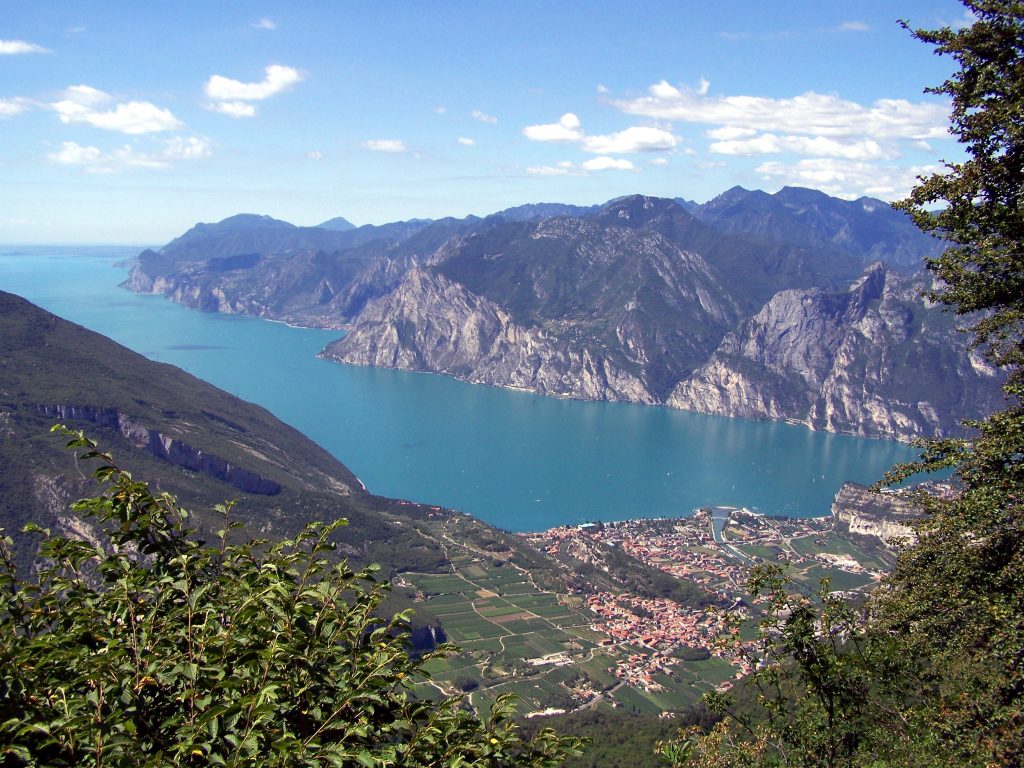
The largest lake in Italy, lined with towns & offering activities like boat rides, swimming & walks.
Lake Garda, in northern Italy, is known for its crystal clear water. At the south end, the town of Sirmione is dominated by the Rocca Scaligera, a fortress with harbor views. The nearby Grotte di Catullo archaeological site includes a Roman villa. On the lake’s western shore, in Gardone Riviera, is Il Vittoriale degli Italiani, former home of poet d’Annunzio. The Dolomites frame Riva del Garda, a resort in the north.
The water temperature in Lake Garda is around 20 °C (68 °F) from June to August, so it remains cool to swim in, even though it depends on the area (the southern part is a bit warmer than the northern one) and especially on the period: during the hottest summers.
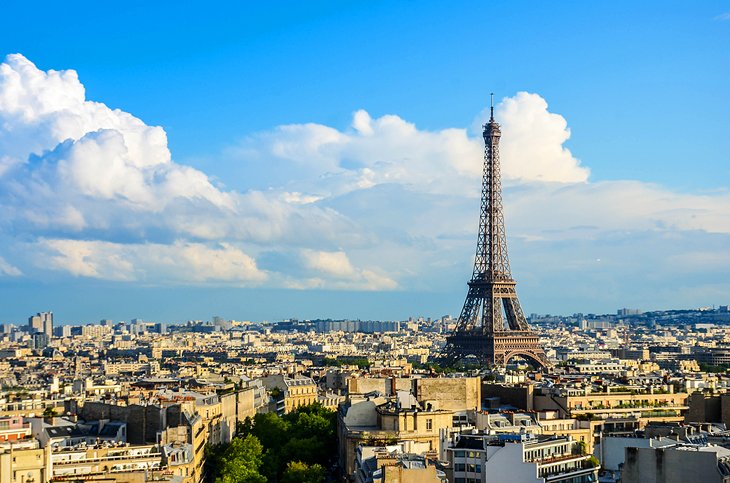
by best-mag | Travel
With an estimated May 2021 population of 67.413 million people, France is the 20th most populous country in the world, the third-most populous in Europe (after Russia and Germany), and the second most populous in the European Union (after Germany).
Most French people are of Celtic-Gallic origin, with a significant admixture of Italic (Romans) and Germanic (Franks) groups reflecting centuries of respective migration and settlement. Through the course of the Middle Ages, France incorporated various neighbouring ethnic and linguistic groups, as evidenced by Breton elements in the west, Aquitanian in the southwest, Scandinavian in the northwest, Alemannic in the northeast, and Ligurian in the southeast.
France is a highly urbanised country, with its largest cities (in terms of metropolitan area population in 2016) being Paris (12,568,755 inh.), Lyon (2,310,850), Marseille (1,756,296), Toulouse (1,345,343), Bordeaux (1,232,550), Lille (1,187,824), Nice (1,006,402), Nantes (961,521), Strasbourg (785,839) and Rennes (727,357).
According to Article 2 of the Constitution, the official language of France is French, a Romance language derived from Latin. Since 1635, the Académie française has been France’s official authority on the French language, although its recommendations carry no legal weight. There are also regional languages spoken in France, such as Occitan, Breton, Catalan, Flemish (Dutch dialect), Alsatian (German dialect), Basque, and Corsican (Italian dialect). Italian was the official language of Corsica until 9 May 1859.
France is a secular country in which freedom of religion is a constitutional right. French religious policy is based on the concept of laïcité, a strict separation of church and state under which public life is kept completely secular.
1-Eiffel Tower

The design of the Eiffel Tower is attributed to Maurice Koechlin and Émile Nouguier, two senior engineers working for the Compagnie des Établissements Eiffel. It was envisioned after discussion about a suitable centerpiece for the proposed 1889 Exposition Universelle, a world’s fair to celebrate the centennial of the French Revolution. Eiffel openly acknowledged that inspiration for a tower came from the Latting Observatory built in New York City in 1853.In May 1884, working at home, Koechlin made a sketch of their idea, described by him as “a great pylon, consisting of four lattice girders standing apart at the base and coming together at the top, joined together by metal trusses at regular intervals”. Eiffel initially showed little enthusiasm, but he did approve further study, and the two engineers then asked Stephen Sauvestre, the head of the company’s architectural department, to contribute to the design. Sauvestre added decorative arches to the base of the tower, a glass pavilion to the first level, and other embellishments.
The puddle iron (wrought iron) of the Eiffel Tower weighs 7,300 tonnes, and the addition of lifts, shops and antennae have brought the total weight to approximately 10,100 tonnes. As a demonstration of the economy of design, if the 7,300 tonnes of metal in the structure were melted down, it would fill the square base, 125 metres (410 ft) on each side, to a depth of only 6.25 cm (2.46 in) assuming the density of the metal to be 7.8 tonnes per cubic metre.Additionally, a cubic box surrounding the tower (324 m × 125 m × 125 m) would contain 6,200 tonnes of air, weighing almost as much as the iron itself. Depending on the ambient temperature, the top of the tower may shift away from the sun by up to 18 cm (7 in) due to thermal expansion of the metal on the side facing the sun.
Gustave Eiffel engraved on the tower the names of 72 French scientists, engineers and mathematicians in recognition of their contributions to the building of the tower. Eiffel chose this “invocation of science” because of his concern over the artists’ protest. At the beginning of the 20th century, the engravings were painted over, but they were restored in 1986–87 by the Société Nouvelle d’exploitation de la Tour Eiffel, a company operating the tower.
Maintenance of the tower includes applying 60 tons of paint every seven years to prevent it from rusting. The tower has been completely repainted at least 19 times since it was built. Lead paint was still being used as recently as 2001 when the practice was stopped out of concern for the environment
The nearest Paris Métro station is Bir-Hakeim and the nearest RER station is Champ de Mars-Tour Eiffel. The tower itself is located at the intersection of the quai Branly and the Pont d’Iéna.
More than 250 million people have visited the tower since it was completed in 1889.In 2015, there were 6.91 million visitors. The tower is the most-visited paid monument in the world. An average of 25,000 people ascend the tower every day which can result in long queues.
The tower has two restaurants: Le 58 Tour Eiffel on the first level, and Le Jules Verne, a gourmet restaurant with its own lift on the second level.From 1937 until 1981, there was a restaurant near the top of the tower. It was removed due to structural considerations; engineers had determined it was too heavy and was causing the tower to sag.
As one of the most iconic landmarks in the world, the Eiffel Tower has been the inspiration for the creation of many replicas and similar towers. An early example is Blackpool Tower in England. The mayor of Blackpool, Sir John Bickerstaffe, was so impressed on seeing the Eiffel Tower at the 1889 exposition that he commissioned a similar tower to be built in his town. It opened in 1894 and is 158.1 m (518 ft) tall.Tokyo Tower in Japan, built as a communications tower in 1958, was also inspired by the Eiffel Tower.
2.Disneyland Paris

Disneyland Paris is an entertainment resort in Chessy, France, 32 km (20 mi) east of Paris. It encompasses two theme parks, resort hotels, Disney Nature Resorts, a shopping, dining and entertainment complex, and a golf course. Disneyland Park is the original theme park of the complex, opening in 1992. A second theme park, Walt Disney Studios Park, opened in 2002. Disneyland Paris celebrated its 25th anniversary in 2017, by when 320 million people had visited, making it the most visited theme park in Europe. It is the second Disney park outside the United States, following the opening of the Tokyo Disney Resort in 1983, and the largest.
Disneyland Paris and its properties have been subject to a number of name changes, initially an effort to overcome the negative publicity that followed the inception of the Euro Disney Resort.
12 April 1992 – 31 May 1994: Euro Disney Resort
1 June – 30 September 1994: Euro Disneyland Paris
1 October 1994 – 15 March 2002, 4 April 2009–present: Disneyland Paris
16 March 2002 – 3 April 2009: Disneyland Resort Paris
Disneyland Paris contains 2 theme parks, 8 resort hotels, 7 associated hotels, a golf course, a high-speed rail station, a large outlet centre (la vallée village), and a large shopping mall: Val d’Europe.
Parks
Disneyland Park opened with the resort on 12 April 1992 and is based on a larger scale of the original Disneyland in California and the Magic Kingdom in Florida.
Walt Disney Studios Park opened on 16 March 2002 celebrating show business, films, and behind-the-scenes
According to the Disneyland Paris website the theme park’s top five attractions in Disneyland Park are It’s a Small World, Star Wars Hyperspace Mountain (formerly known as Space Mountain: Mission 2), Big Thunder Mountain, Pirates of the Caribbean, and Buzz Lightyear’s Astro Blasters. It’s a Small World, located in Fantasyland, takes visitors on a musical tour of world attractions;Star Tours and Hyperspace Mountain (which is a roller coaster) are situated in the Discoveryland district; Big Thunder Mountain is a mine train roller coaster within Frontierland; Pirates of the Caribbean is located in Adventureland; and Buzz Lightyear’s Astro Blasters, also located in Discoveryland, was inspired by the Disney/Pixar film Toy Story 2 and features people attempting to successfully shoot lasers at seemingly moving targets to earn as many points as possible.
3.Louvre Museum
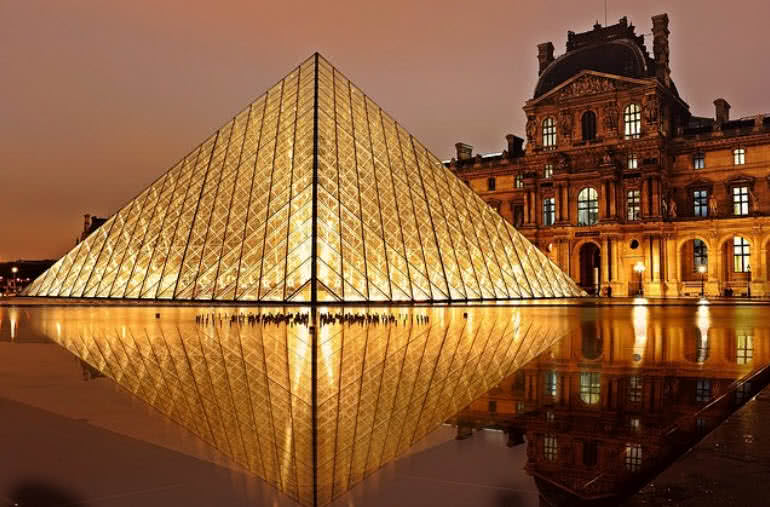
The Louvre museum is located inside the Louvre Palace, in the center of Paris, adjacent to the Tuileries Gardens. The two nearest Métro stations are Louvre-Rivoli and Palais Royal-Musée du Louvre, the latter having a direct underground access to the Carrousel du Louvre commercial mall.
Before the Grand Louvre overhaul of the late 1980s and 1990s, the Louvre had several street-level entrances, most of which are now permanently closed. Since 1993, the museum’s main entrance has been the underground space under the Louvre Pyramid, or Hall Napoléon, which can be accessed from the Pyramid itself, from the underground Carrousel du Louvre, or (for authorized visitors) from the passage Richelieu connecting to the nearby rue de Rivoli. A secondary entrance at the Porte des Lions, near the western end of the Denon Wing, was created in 1999 but is not permanently open.
The Louvre Palace, which houses the museum, was begun by King Philip II in the late 12th century to protect the city from the attack from the West, as the Kingdom of England still held Normandy at the time. Remnants of the Medieval Louvre are still visible in the crypt. Whether this was the first building on that spot is not known, and it is possible that Philip modified an existing tower.
The Louvre finally became a public museum during the French Revolution. In May 1791, the National Constituent Assembly declared that the Louvre would be “a place for bringing together monuments of all the sciences and arts”.On 10 August 1792, Louis XVI was imprisoned and the royal collection in the Louvre became national property. Because of fear of vandalism or theft, on 19 August, the National Assembly pronounced the museum’s preparation as urgent. In October, a committee to “preserve the national memory” began assembling the collection for display
The Louvre (English: /ˈluːv(rə)/ LOOV(-rə)), or the Louvre Museum (French: Musée du Louvre (audio speaker iconlisten)), is the world’s most-visited museum, and a historic landmark in Paris, France. It is the home of some of the best-known works of art, including the Mona Lisa and the Venus de Milo. A central landmark of the city, it is located on the Right Bank of the Seine in the city’s 1st arrondissement (district or ward). At any given point in time, approximately 38,000 objects from prehistory to the 21st century are being exhibited over an area of 72,735 square meters (782,910 square feet). Attendance in 2021 was 2.8 million due to the COVID-19 pandemic. The museum was closed for 150 days in 2020, and attendance plunged by 72 percent to 2.7 million. Nonetheless, the Louvre still topped the list of most-visited art museums in the world in 2020.
The museum is housed in the Louvre Palace, originally built in the late 12th to 13th century under Philip II. Remnants of the Medieval Louvre fortress are visible in the basement of the museum. Due to urban expansion, the fortress eventually lost its defensive function, and in 1546 Francis I converted it into the primary residence of the French Kings.The building was extended many times to form the present Louvre Palace. In 1682, Louis XIV chose the Palace of Versailles for his household, leaving the Louvre primarily as a place to display the royal collection, including, from 1692, a collection of ancient Greek and Roman sculpture. In 1692, the building was occupied by the Académie des Inscriptions et Belles-Lettres and the Académie Royale de Peinture et de Sculpture, which in 1699 held the first of a series of salons. The Académie remained at the Louvre for 100 years. During the French Revolution, the National Assembly decreed that the Louvre should be used as a museum to display the nation’s masterpieces.
4.Palace of Versailles
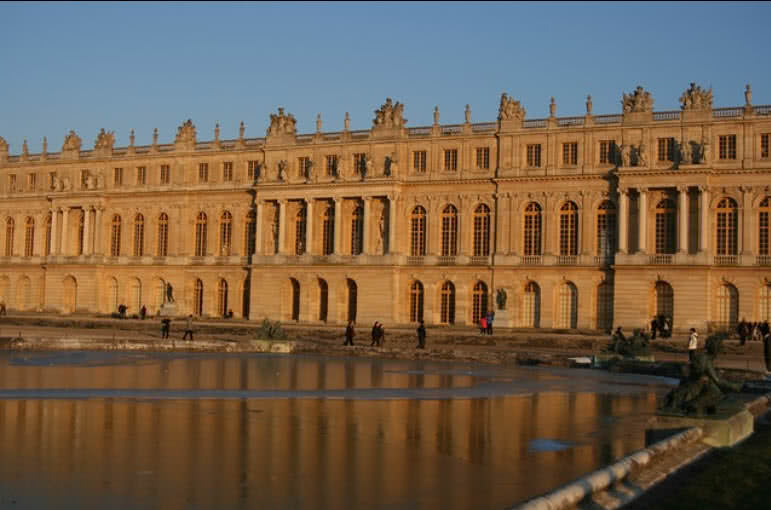
The estate of Versailles consists of the palace, the subsidiary buildings around it, and its park and gardens. As of June 2021, the estate altogether covers an area of 800 hectares (8.0 km2; 2,000 acres), with the park and gardens laid out to the south, west, and north of the palace. The palace is approached from the east by the Avenue de Paris , measuring 17 miles (27 km) from Paris to a gate between the Grande and Petite Écuries . Beyond these stables is the Place d’Armes where the Avenue de Paris meets the Avenue de Sceaux and Avenue de Saint-Cloud (see map), the three roads that formed the main arteries of the city of Versailles.Exactly where the three roads meet is a gate leading into the cour d’honneur hemmed in by the Ministers’ Wings Beyond is the Royal Gate and the main palace,which wraps around the Royal and finally Marble Courts
The estate was established by Louis XIII as a hunting retreat, with a park just to the west of his château.From 1661, Louis XIV expanded the estate until, at its greatest extent, the estate was made up by the Grand Parc [fr], a hunting ground of 15,000 hectares (150 km2; 37,000 acres), and the gardens, called the Petit Parc,which covered 1,700 hectares (17 km2; 4,200 acres). A 25-mile (40 km) long, 10-foot (3.0 m) high wall with 24 gateways enclosed the estate.
In 2003, a new restoration initiative – the “Grand Versailles” project – was started, which began with the replanting of the gardens, which had lost over 10,000 trees during Hurricane Lothar on 26 December 1999. One part of the initiative, the restoration of the Hall of Mirrors, was completed in 2006. Another major project was the further restoration of the backstage areas Royal Opera of Versailles, which was completed on 9 April 1957.
The Palace of Versailles is currently owned by the French state. Its formal title is the Public Establishment of the Palace, Museum and National Estate of Versailles. Since 1995, it has been run as a Public Establishment, with an independent administration and management supervised by the French Ministry of Culture.
The Palace of Versailles (/vɛərˈsaɪ, vɜːrˈsaɪ/ vair-SY, vur-SY; French: Château de Versailles is a former royal residence located in Versailles, about 12 miles (19 km) west of Paris, France. The palace is owned by the French Republic and has since 1995 been managed, under the direction of the French Ministry of Culture, by the Public Establishment of the Palace, Museum and National Estate of Versailles. 15,000,000 people visit the Palace, Park, or Gardens of Versailles every year, making it one of the most popular tourist attractions in the world. However, due to the COVID-19 pandemic, the number of paying visitors to the Chateau dropped by 75 percent from eight million in 2019 to two million in 2020. The drop was particularly sharp among foreign visitors, who account for eighty percent of paying visitors.
5.Mont Saint-Michel
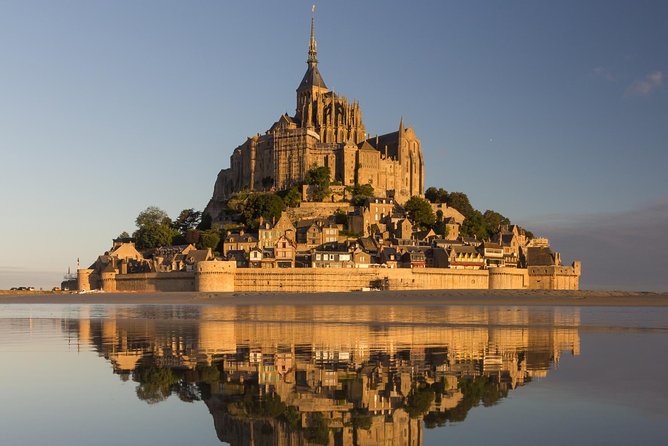
Mont-Saint-Michel was used in the sixth and seventh centuries as an Armorican stronghold of Gallo-Roman culture and power until it was ransacked by the Franks, thus ending the trans-channel culture that had stood since the departure of the Romans in 460. From roughly the fifth to the eighth century, Mont Saint-Michel belonged to the territory of Neustria and, in the early ninth century, was an important place in the marches of Neustria.
Le Mont-Saint-Michel(French pronunciation: [lə mɔ̃ sɛ̃ miʃɛl]; Norman: Mont Saint Miché, English: Saint Michael’s Mount) is a tidal island and mainland commune in Normandy, France.
The islandlies approximately one kilometre (0.6 miles) off the country’s north-western coast, at the mouth of the Couesnon River near Avranches and is 7 hectares (17 acres) in area. The mainland part of the commune is 393 hectares (971 acres) in area so that the total surface of the commune is 400 hectares (988 acres).As of 2019, the island had a population of 29.
The commune’s position—on an island just a few hundred metres from land—made it accessible at low tide to the many pilgrims to its abbey, but defensible as an incoming tide stranded, drove off, or drowned would-be assailants. The island remained unconquered during the Hundred Years’ War; a small garrison fended off a full attack by the English in 1433.Louis XI recognised the reverse benefits of its natural defence and turned it into a prison. The abbey was used regularly as a prison during the Ancien Régime.
The connection between the Mont Saint-Michel and the mainland has changed over the centuries. Previously connected by a tidal causeway uncovered only at low tide, this was converted into a raised causeway in 1879, preventing the tide from scouring the silt around the mount. The coastal flats have also been polderised to create pastureland, decreasing the distance between the shore and the island, and the Couesnon River has been canalised, reducing the dispersion of the flow of water. These factors all encouraged silting-up of the bay.
6.Verdon Gorge
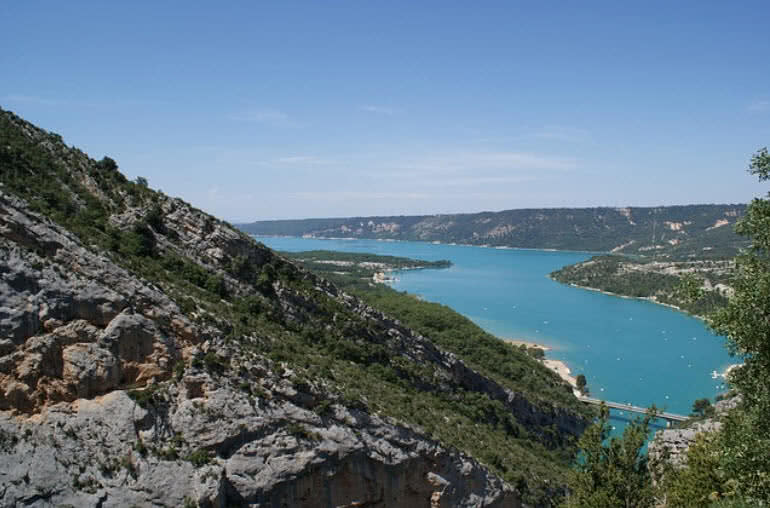
The Monastic Fraternities of JerusaDuring the Triassic period, the Provence subsided and was covered by the sea, leaving thick layers of various limestone deposits. Several million years later, with the arrival of the Jurassic period, the area was covered by a warm shallow sea, which allowed the growth of various Corals. The Cretaceous period saw what is now Basse Provence being raised and the sea reaching the current location of the Alps, which were themselves erected during the tertiary era. As a result of the large-scale geological activity, many of the Jurassic limestone deposits fractured, forming relief with valleys and other such features. The origins of the Verdon Gorge can be traced to this era.
The dawn of the Quaternary period had large-scale glaciation, transforming water pockets and lakes into rivers of ice, which remodeled the topography, scouring and striating the landscape.At the end of this activity, erosion by rivers continued, forming the Gorge as it is today.The Verdon’s riverbed was scoured for a second time of the accumulated coral and limestone sediments, by a water delivery rate nearing 2000 to 3000 cubic metres per second.lem
Geography
The source of the Verdon is close to the col d’Allos hill in the Trois Eveches mountain range, whence it continues, flowing into the Durance river near Vinon-sur-Verdon after traveling 175 kilometres. Between Castellane and the Galetas bridge, the river passes through the lake of Sainte-Croix, created by the construction of a dam of the same name. Before the dam was constructed, the village of Les Salles-sur-Verdon occupied the river plain. To create the reservoir, the village was destroyed in 1973. Les Salles-sur-Verdon was reconstructed as a more modern settlement higher up the valley. Today, it is the youngest village in France.
For some distance the Verdon Gorge forms the border between the départements of Var to the south and Alpes-de-Haute-Provence to the north in the Provence-Alpes-Côte d’Azur région.
This region between Castellane and the Lac de Sainte-Croix is called the Gorges du Verdon, or Verdon Gorge. It is split into three distinct parts:
“Prégorges” (‘pre-gorge’), from Castellane to Pont de Soleils,
the deepest part of the Gorge, from Pont de Soleils to l’Imbut, and
the Canyon from l’Imbut to the Pont de Galetas.
The Verdon Gorge is narrow and deep, with depths of 250 to 700 metres and widths of 6 to 100 metres at the level of the Verdon river. It is 200 to 1500 metres wide from one side of the Gorge to the other at the summits. The Gorge has been compared to the Grand Canyon in the United States.
Tourism
The Verdon Gorge attracts numerous tourists, especially during the summer period. The river’s turquoise colour is associated with glacial sources and the minerals of rock flour suspended in the water.
It is easily accessible on its right bank from the north (via route D952 from Castellane to Moustiers-Sainte-Marie), and on its left bank from the south (via routes D71, D90 and D955 from Aiguines to Castellane).
7.Château de Chambord
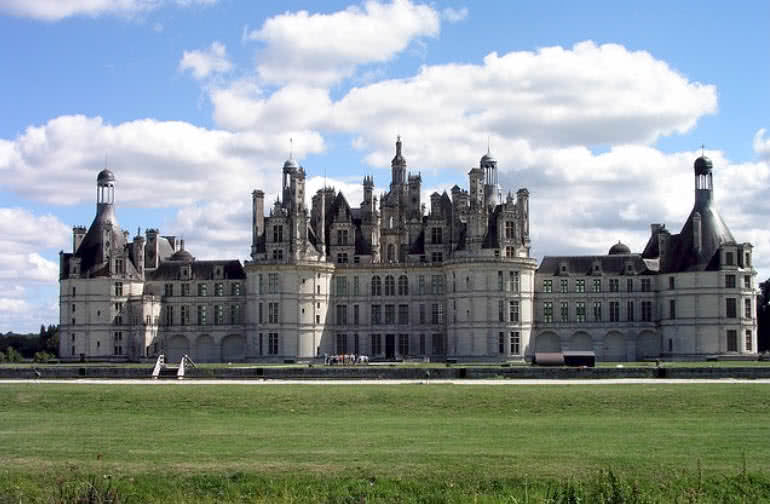
The Château de Chambord in Chambord, Centre-Val de Loire, France, is one of the most recognisable châteaux in the world because of its very distinctive French Renaissance architecture which blends traditional French medieval forms with classical Renaissance structures
Son architecture incomparable, la richesse de son mobilier et de son histoire, la beauté de ses jardins font de Chenonceau l’un des châteaux les plus populaires en France.
Avec ses 67 000 m² et ses 700 pièces, Versailles détient le record du plus grand château du monde, talonné par le château de Windsor, qui lui se place en tête des plus grands palais encore habités, puisque l’édifice est encore la résidence officielle de la reine.le château de Versailles bien sûr ! En effet, la résidence officielle des Rois de France et ses jardins se placent en seconde position des sites culturels les plus visités de France, juste devant la Tour Eiffel
Tarifs groupes 2022 droit d’entrée château et jardins (par personne, à partir de 20 personnes payantes) : 12 euros : adulte (tarif public : 14,50 euros ) 3 euros : 6-17 ans de mars à octobre.































